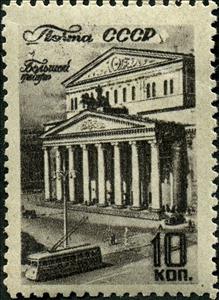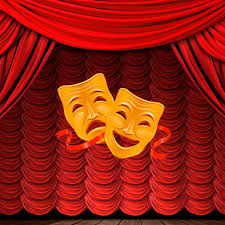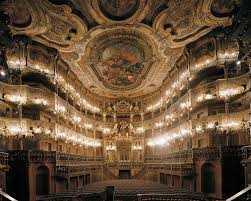Stamp: Bolshoi Theatre (Soviet Union, USSR 1946)
Bolshoi Theatre (Soviet Union, USSR 1946)
01 January (Soviet Union, USSR ) within release 10th Death Anniversary of Maxim Gorky goes into circulation Stamp Bolshoi Theatre face value 10 Russian kopek
| Stamp Bolshoi Theatre in catalogues | |
|---|---|
| Michel: | Mi:SU 1057 |
Stamp is square format.
Also in the issue 10th Death Anniversary of Maxim Gorky:
- Stamp - Medal "For Valiant Labour in the Great Patriotic War" face value 30;
- Stamp - Medal "For Victory over Germany in the Great Patriotic War" face value 30;
- Stamp - Medal "For Valiant Labour in the Great Patriotic War" face value 60;
- Stamp - Medal "For Victory over Germany in the Great Patriotic War" face value 60;
- Stamp - Long Live Our Victory! face value 60;
- Stamp - Coat of Arms of the Soviet Union face value 30;
- Stamp - Spasskaya Tower of the Moscow Kremlin face value 45;
- Stamp - Coat of Arms of the Soviet Union face value 60;
- Stamp - Artillery on Red Square face value 60;
- Stamp - Artillery on Red Square face value 2;
- Stamp - Victory parade on Red Square face value 3;
- Stamp - Pafnuty L. Chebyshev (1821-1894), Russian mathematician face value 30;
- Stamp - Pafnuty L. Chebyshev (1821-1894), Russian mathematician face value 60;
- Stamp - Order of Lenin face value 60;
- Stamp - Medal "Hammer and Sickle" face value 60;
- Stamp - Order of the Red Banner of Labour face value 60;
- Stamp - Order of the Red Star face value 60;
- Stamp - Gold Star medal face value 60;
- Stamp - Order of the Badge of Honour face value 60;
- Stamp - Order of the Red Banner face value 60;
- Stamp - Medal for Battle Merit face value 60;
- Stamp - Medal "For the Defence of the Caucasus" face value 60;
- Stamp - Medal "For Labour Valour" face value 60;
- Stamp - Marshal's Star face value 60;
- Stamp - Medal "For Courage" face value 60;
- Stamp - Medal "For the Defence of the Soviet Transarctic" face value 60;
- Stamp - Medal "For the Defence of Moscow" face value 60;
- Stamp - Medal "For Distinguished Labour" face value 60;
- Stamp - Mikhail I. Kalinin (1875-1946), Soviet statesman face value 20;
- Stamp - Sukhumi face value 15;
- Stamp - Gagry face value 30;
- Stamp - Sochi. Riviera Park face value 30;
- Stamp - Novy Afon face value 45;
- Stamp - Maxim Gorky (1868-1936), Russian author face value 30;
- Stamp - Maxim Gorky (1868-1936), Russian author face value 60;
- Stamp - Athletes carrying flags and portrait of Joseph Stalin face value 30;
- Stamp - Medal "For the Defence of the Caucasus" face value 1;
- Stamp - Ivan the Great Bell Tower face value 5;
- Stamp - Bolshoi Theatre face value 10;
- Stamp - Hotel Moskva face value 15;
- Stamp - Sverdlov Square face value 20;
- Stamp - View of the Kremlin from the Moscow River face value 45;
- Stamp - View of Red Square. Saint Basil's Cathedral face value 60;
- Stamp - Monument of Minin and Pozharsky against the Spasskaya Tower face value 1;
- Stamp - Column of tanks on Red Square, Moscow face value 30;
- Stamp - Column of tanks on Red Square, Moscow face value 60;
- Stamp - A wheat sheaf. Combine harvester. face value 5;
- Stamp - Oil field and rigs face value 10;
- Stamp - Transportation of coal. Miner face value 15;
- Stamp - In the steel manufactory face value 20;
- Stamp - Steelworkers at the blast furnaces face value 30;
- Stamp - Soviet stamps on contour map of the USSR face value 15;
- Stamp - 1st Soviet Postage Stamp face value 30;
- Stamp - Images of Soviet stamps face value 60;
- Stamp - Bas-relief "Lenin and Stalin". Spasskaya Tower face value 30;
- Stamp - Bas-relief "Lenin and Stalin". Spasskaya Tower face value 30;
- Stamp - Bas-relief "Lenin and Stalin". Spasskaya Tower face value 30;
- Stamp - Nikolay A. Nekrasov (1821-1878), Russian poet face value 30;
- Stamp - Nikolay Nekrasov (1821-1878), Russian poet face value 60;
- Stamp - The right side of the badge "Laureate of Stalin Prize" face value 30;
- Stamp - Reconstrusting Dam of Dnieper Hydroelectric Station face value 30;
- Stamp - Reconstrusting Dam of Dnieper Hydroelectric Station face value 60;
|
Data entry completed
50%
|
|
|---|---|
| Stamp Bolshoi Theatre in digits | |
| Country: | Soviet Union, USSR |
| Date: | 1946-01-01 |
| Perforation: | 12½ |
| Format: | Stamp |
| Face Value: | 10 Russian kopek |
| Print run: | 3000000 |
Stamp Bolshoi Theatre it reflects the thematic directions:
Architecture (Latin architectura, from the Greek ἀρχιτέκτων arkhitekton "architect", from ἀρχι- "chief" and τέκτων "builder") is both the process and the product of planning, designing, and constructing buildings and other physical structures. Architectural works, in the material form of buildings, are often perceived as cultural symbols and as works of art. Historical civilizations are often identified with their surviving architectural achievements.
Theatre or theater is a collaborative form of performing art that uses live performers, usually actors or actresses, to present the experience of a real or imagined event before a live audience in a specific place, often a stage. The performers may communicate this experience to the audience through combinations of gesture, speech, song, music, and dance. It is the oldest form of drama, though live theatre has now been joined by modern recorded forms. Elements of art, such as painted scenery and stagecraft such as lighting are used to enhance the physicality, presence and immediacy of the experience. Places, normally buildings, where performances regularly take place are also called "theatres" (or "theaters"), as derived from the Ancient Greek θέατρον (théatron, "a place for viewing"), itself from θεάομαι (theáomai, "to see", "to watch", "to observe").
A tram (also known as a streetcar or trolley in the United States and Canada) is a type of urban rail transit consisting of either individual railcars or self-propelled multiple unit trains that run on tramway tracks on urban public streets; some include segments on segregated right-of-way The tramlines or tram networks operated as public transport are called tramways or simply trams/streetcars. Due to their close similarities, trams are commonly included in the wider term light rail,which also includes systems separated from other traffic.
A building or edifice is a structure with a roof and walls standing more or less permanently in one place, such as a house or factory. Buildings come in a variety of sizes, shapes and functions, and have been adapted throughout history for a wide number of factors, from building materials available, to weather conditions, to land prices, ground conditions, specific uses and aesthetic reasons. Buildings serve several needs of society – primarily as shelter from weather, security, living space, privacy, to store belongings, and to comfortably live and work. A building as a shelter represents a physical division of the human habitat (a place of comfort and safety) and the outside (a place that at times may be harsh and harmful).
An opera house is a theater building used for performances of opera. Like many theaters, it usually includes a stage, an orchestra pit, audience seating, backstage facilities for costumes and building sets, as well as offices for the institution's administration.





